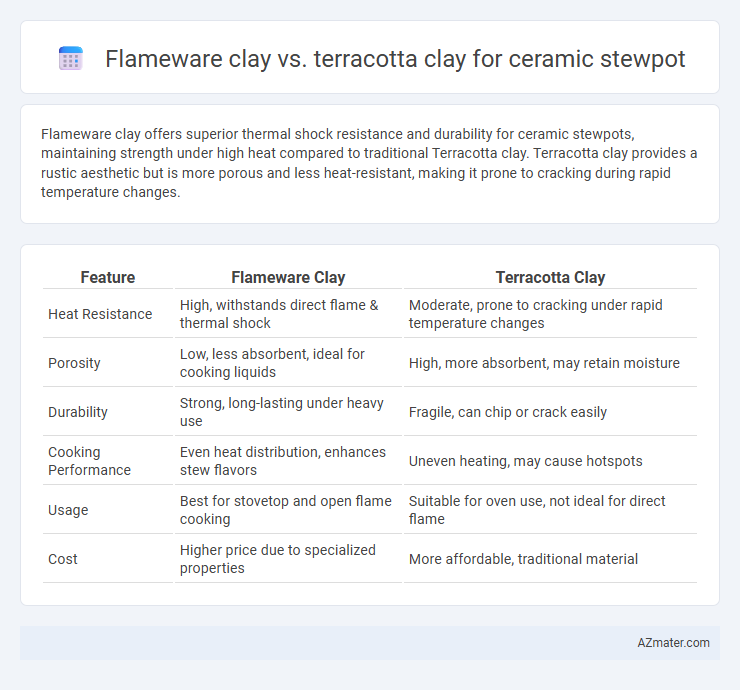Flameware clay offers superior thermal shock resistance and durability for ceramic stewpots, maintaining strength under high heat compared to traditional Terracotta clay. Terracotta clay provides a rustic aesthetic but is more porous and less heat-resistant, making it prone to cracking during rapid temperature changes.
Table of Comparison
| Feature | Flameware Clay | Terracotta Clay |
|---|---|---|
| Heat Resistance | High, withstands direct flame & thermal shock | Moderate, prone to cracking under rapid temperature changes |
| Porosity | Low, less absorbent, ideal for cooking liquids | High, more absorbent, may retain moisture |
| Durability | Strong, long-lasting under heavy use | Fragile, can chip or crack easily |
| Cooking Performance | Even heat distribution, enhances stew flavors | Uneven heating, may cause hotspots |
| Usage | Best for stovetop and open flame cooking | Suitable for oven use, not ideal for direct flame |
| Cost | Higher price due to specialized properties | More affordable, traditional material |
Introduction to Flameware and Terracotta Clays
Flameware clay is a high-temperature stoneware clay formulated to withstand thermal shock, making it ideal for ceramic stewpots used directly on stovetops or open flames. Terracotta clay, a porous earthenware clay, offers excellent heat retention but is more fragile and prone to cracking under sudden temperature changes. Choosing between Flameware and Terracotta depends on the stewpot's intended use, with Flameware providing superior durability and thermal resistance for cooking applications.
Key Differences Between Flameware and Terracotta
Flameware clay offers higher thermal shock resistance and durability compared to terracotta clay, making it ideal for ceramic stewpots exposed to direct flame and rapid temperature changes. Terracotta clay, while porous and breathable, is more fragile and suited for slow-cooking applications due to its lower heat tolerance. The key differences include flameware's dense, non-porous composition versus terracotta's permeable texture, affecting heat retention and durability in cookware.
Heat Resistance and Thermal Shock Properties
Flameware clay offers superior heat resistance compared to traditional terracotta clay, making it ideal for ceramic stewpots exposed to direct flame or high oven temperatures. Its enhanced thermal shock properties prevent cracking during rapid temperature changes, which is a common issue with terracotta clay due to its porous nature. Terracotta stewpots provide good heat retention but may require careful temperature management to avoid thermal stress and potential breakage.
Cooking Performance and Flavor Impact
Flameware clay offers superior heat retention and even distribution, enhancing the cooking performance of ceramic stewpots by maintaining consistent temperatures for slow simmering and reducing hot spots. Terracotta clay, while porous and breathable, provides a more rustic heat transfer that can slightly alter flavor by allowing moisture evaporation, intensifying the stew's aroma. Choosing flameware clay ensures a balanced, well-cooked stew with nuanced flavor while terracotta imparts a traditional earthy taste influenced by its natural porosity.
Durability and Longevity Considerations
Flameware clay offers superior durability and heat resistance compared to traditional terracotta clay, making it ideal for ceramic stewpots exposed to high cooking temperatures. Its vitrified texture minimizes porosity, enhancing longevity by preventing cracks and moisture absorption that commonly affect terracotta over time. Terracotta clay, while aesthetically pleasing and traditional, is more susceptible to chipping and thermal shock, resulting in shorter lifespan under frequent use.
Safety and Toxicity Aspects
Flameware clay is specifically formulated to withstand direct high heat without cracking, making it ideal for ceramic stewpots used on stovetops, and it is typically free from harmful heavy metals and toxic glazes, ensuring food safety. Terracotta clay, while widely used in cookware, is more porous and usually requires thorough glazing to prevent absorption of liquids and potential leaching of lead or other toxins, which can pose health risks if untreated or improperly fired. For optimal safety and reduced toxicity, Flameware clay offers superior heat resistance and controlled chemical composition compared to traditional Terracotta.
Maintenance and Cleaning Requirements
Flameware clay, known for its high durability and heat resistance, requires minimal maintenance and is less prone to cracking or chipping compared to terracotta clay. Terracotta clay, while offering excellent heat retention, demands careful cleaning to prevent moisture absorption and potential mold growth, often necessitating thorough drying after each use. Both materials benefit from gentle hand washing, but Flameware clay is generally more forgiving, making it a practical choice for low-maintenance ceramic stewpot care.
Suitability for Stewpot Cooking Techniques
Flameware clay offers superior thermal shock resistance, making it highly suitable for ceramic stewpot cooking techniques that require frequent temperature changes or direct flame exposure. Terracotta clay, while porous and excellent for slow, even heat distribution, is more prone to cracking under rapid temperature shifts, limiting its use in aggressive stovetop cooking methods. For stewpots, the choice depends on whether durability under direct heat (favoring Flameware) or natural moisture retention and breathability (favoring Terracotta) is prioritized.
Price and Availability Comparison
Flameware clay generally comes at a higher price point compared to terracotta clay due to its specialized composition and enhanced thermal properties, making it particularly suitable for ceramic stewpots designed for high heat retention and durability. Terracotta clay is widely available and more affordable, often favored for its traditional aesthetic and ease of sourcing from numerous suppliers worldwide. Both clays have distinct market availability, with terracotta being more prevalent in general pottery markets, while flameware clay may require sourcing from specialized ceramic material vendors.
Choosing the Right Clay for Your Ceramic Stewpot
Flameware clay offers superior thermal shock resistance and durability, making it ideal for ceramic stewpots that require frequent exposure to direct flame and high temperatures. Terracotta clay provides excellent porosity and natural heat retention but is more brittle and less resistant to thermal stress, suitable for slow cooking at moderate heat. Choosing the right clay depends on your cooking style: opt for flameware for stovetop use and terracotta for oven-based, gentle simmering recipes.

Infographic: Flameware clay vs Terracotta clay for Ceramic stewpot
 azmater.com
azmater.com